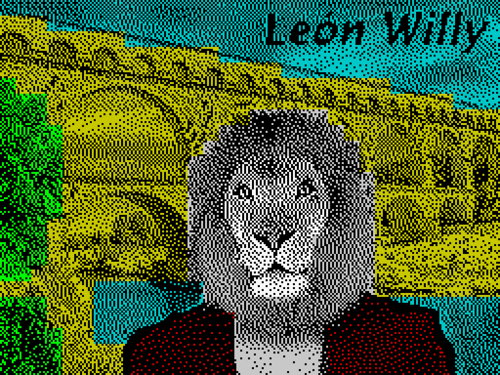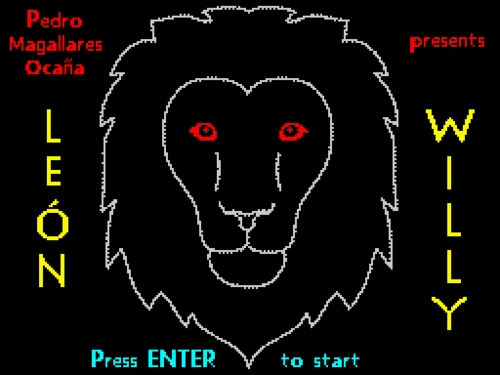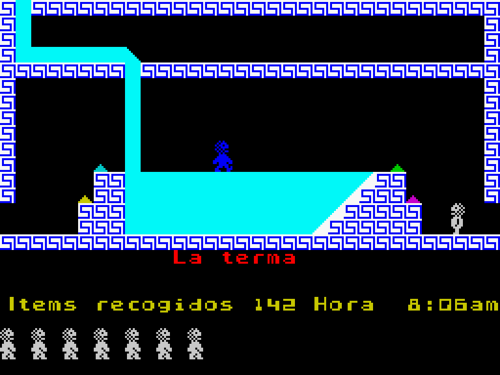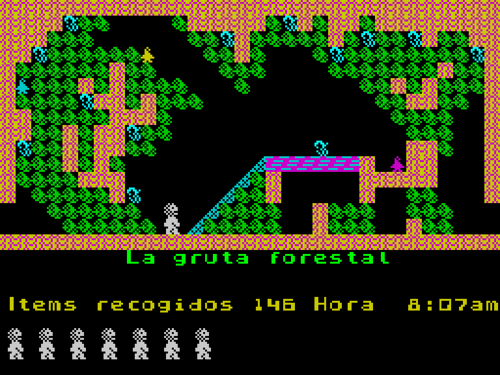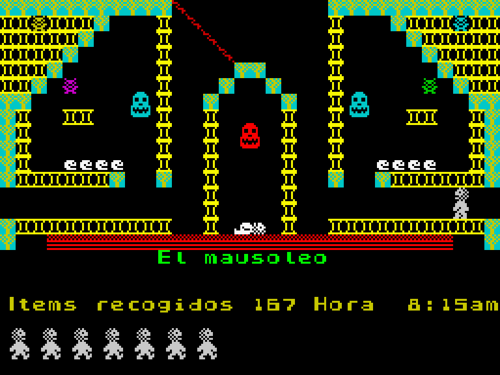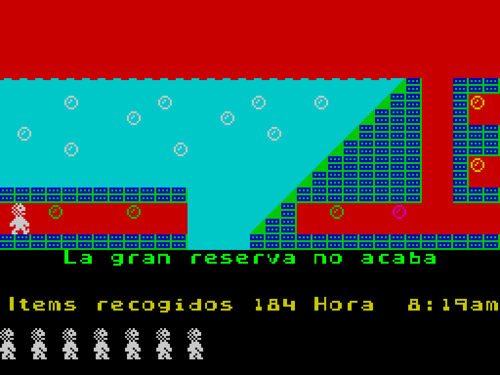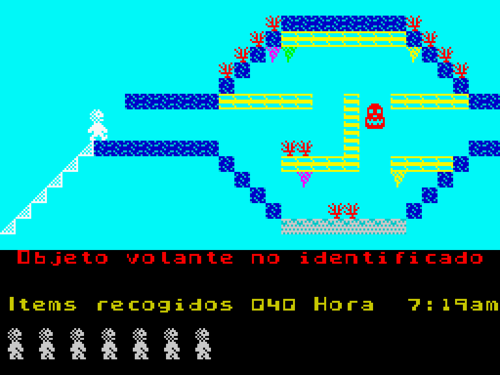-
Posts
3,229 -
Joined
-
Last visited
Everything posted by jetsetdanny
-
Great to see you here! Welcome to the forum 🙂. Any chance you might create another version of the stone-cold classic?
-

Gaming competitively and how it applies to Miner Willy
jetsetdanny replied to DigitalDuck's topic in MM
That's great, thank you! 👍 -

Gaming competitively and how it applies to Miner Willy
jetsetdanny replied to DigitalDuck's topic in MM
They could use the lists on JSW Central to define the difference 😉. One of the things I feel very strongly about is the difference between what can be considered new games and the 'versions and minor mods' of the two original games. JSW Central makes this distinction very clear by placing them on different lists: one for new games, and two others for the minor mods and versions of MM and of JSW, respectively. Just a suggestion 😉. -

Gaming competitively and how it applies to Miner Willy
jetsetdanny replied to DigitalDuck's topic in MM
Why? Many of them are actually much better (more interesting, better graphically, more challenging, etc.) than the original games. -
You die. It depends. I'm not planning to investigate it 'scientifically' or at the code level, but I have a strong impression that if in the upper ("red") room you exceed the height from which you could normally fall safely (within that room), once you land in the "green" room below, you die. However, if in the upper "red" room you don't exceed the safe height, you'll be perfectly fine in the "green" room below no matter how far you fall in that latter room. You can see it for example in the rooms "Peces voladores"/"Flying Fish" (I'll call it Room A) and "La entrada a Magna City"/"Entrance to Magna City" (I'll call it Room B). If you drop down to Room B from the floor level or Room A (or even from the lower end of the ramp-conveyor), you are perfectly fine down in Room B, you land safely. However, if you drop down to Room B from the platform in Room A where the middle item is, you are in for a Multiple Death Scenario in Room B below.
-
And so the game has now been released! 😁 Please see the announcement for more info and the download link.
-
View File León Willy I am delighted to announce, on behalf of Pedro Magallares Ocaña, the release of his game “León Willy”. It utilises the standard JSW48 game engine, albeit with some modifications, featuring 64 brand-new rooms and 256 items to collect. The game also showcases 14 in-game tunes and a title-screen tune that have never been used in any JSW game before. Pedro designed the game in 2001, creating a navigable and charming environment inspired by ancient cultures, historical events, movies, songs and his personal life. He published it on a Spanish forum dedicated to the video game scene, especially consoles, a few years later. That version did not seem to reach fans within the MM & JSW community though. Fast forward to this year, where the game has been reborn and rejuvenated. Pedro graciously allowed me to handle some 'postproduction' aspects, including custom loading and title screens, musical arrangements, and a few other enhancements. The definitive version you can now download (in Spanish and English) showcases León Willy in his full feline prowess. Willy wakes up after a very crazy night, disoriented and uncertain of his whereabouts, with the events of the previous night shrouded in mystery. His surroundings appear somehow transformed. Slowly, he recalls acquiring a new residence somewhere in Spain. The name "Villamagna" echoes persistently in his mind. As Willy rubs the sleep from his eyes, a strange weight tugs at his head. Panic sets in as his fingers trace the features that now adorn his face. The once-smooth contours have been replaced by coarse fur, and his once-familiar nose has elongated into a feline snout. His breath catches in his throat as he touches the majestic, flowing mane that surrounds his head like a golden crown. In disbelief, Willy stumbles towards the mirror, praying that the reflection would dispel the absurdity of his imagination. Yet, staring back at him is a creature he could never have anticipated. His eyes widen with shock and wonder as the golden eyes of a lion meet his gaze… Please refer to the Readme for the rest of the background story, Pedro’s narrative about the history of the game and its various sources of inspiration, instructions, and detailed credits, acknowledgments, and thanks. Apart from its atmospheric and diverse rooms, the game introduces some technical novelties. It is likely the first JSW48 game where, in some rooms, you can survive a fall from any height, while in others, you will meet your demise. This is clearly indicated by the colour of the room name - if it's green, you can fall safely, but if it's red, exceeding the normal falling height will result in death. Another novelty involves the (varied) in-game tunes. The tune initiates from the first note if a different tune was playing before Willy entered the current room; however, it continues if the same tune was already playing. This should enhance the listening experience of the in-game music, which mostly consists of tunes from the Spanish-speaking world. I trust you will enjoy Pedro’s debut game, and I hope that your positive feedback will encourage him to design more JSW games 🙂. Submitter jetsetdanny Submitted 11/10/2023 Category Jet Set Willy [Remakes]
-
- leon willy
- pedro magallares
-
(and 4 more)
Tagged with:
-
50 downloads
I am delighted to announce, on behalf of Pedro Magallares Ocaña, the release of his game “León Willy”. It utilises the standard JSW48 game engine, albeit with some modifications, featuring 64 brand-new rooms and 256 items to collect. The game also showcases 14 in-game tunes and a title-screen tune that have never been used in any JSW game before. Pedro designed the game in 2001, creating a navigable and charming environment inspired by ancient cultures, historical events, movies, songs and his personal life. He published it on a Spanish forum dedicated to the video game scene, especially consoles, a few years later. That version did not seem to reach fans within the MM & JSW community though. Fast forward to this year, where the game has been reborn and rejuvenated. Pedro graciously allowed me to handle some 'postproduction' aspects, including custom loading and title screens, musical arrangements, and a few other enhancements. The definitive version you can now download (in Spanish and English) showcases León Willy in his full feline prowess. Willy wakes up after a very crazy night, disoriented and uncertain of his whereabouts, with the events of the previous night shrouded in mystery. His surroundings appear somehow transformed. Slowly, he recalls acquiring a new residence somewhere in Spain. The name "Villamagna" echoes persistently in his mind. As Willy rubs the sleep from his eyes, a strange weight tugs at his head. Panic sets in as his fingers trace the features that now adorn his face. The once-smooth contours have been replaced by coarse fur, and his once-familiar nose has elongated into a feline snout. His breath catches in his throat as he touches the majestic, flowing mane that surrounds his head like a golden crown. In disbelief, Willy stumbles towards the mirror, praying that the reflection would dispel the absurdity of his imagination. Yet, staring back at him is a creature he could never have anticipated. His eyes widen with shock and wonder as the golden eyes of a lion meet his gaze… Please refer to the Readme for the rest of the background story, Pedro’s narrative about the history of the game and its various sources of inspiration, instructions, and detailed credits, acknowledgments, and thanks. Apart from its atmospheric and diverse rooms, the game introduces some technical novelties. It is likely the first JSW48 game where, in some rooms, you can survive a fall from any height, while in others, you will meet your demise. This is clearly indicated by the colour of the room name - if it's green, you can fall safely, but if it's red, exceeding the normal falling height will result in death. Another novelty involves the (varied) in-game tunes. The tune initiates from the first note if a different tune was playing before Willy entered the current room; however, it continues if the same tune was already playing. This should enhance the listening experience of the in-game music, which mostly consists of tunes from the Spanish-speaking world. I trust you will enjoy Pedro’s debut game, and I hope that your positive feedback will encourage him to design more JSW games 🙂.-
- leon willy
- pedro magallares
-
(and 4 more)
Tagged with:
-
"León Willy" will be released this Friday in the late afternoon or early evening European time 🙂 . It will probably be the first JSW48 game (I can't recall any precedents) where in some rooms you can survive a fall from any height, and in others you will die. This is clearly marked by the colour of the room name - if it's green, it means you call fall safely, if it's red, you will die if you exceed the height from which Willy can normally fall. There are 64 rooms in the game and 256 items to collect (which can be achieved without losing a single life). Some screenshots ahead of the release:
-
A brand-new JSW game by a debut author is set to be released next weekend, barring any unexpected developments. The game's name is "León Willy" and it was created by Pedro Magallares Ocaña. The game, along with its documentation, will be available in two language versions: English and Spanish (Pedro is a Spaniard). Navigating the game is relatively easy, offering a delightful and interesting environment inspired by ancient cultures, historical events, movies, songs, and the author's personal life. Stay tuned for the official announcement here – be on the lookout! 🙂
-

Jet Set Willy: Role Reversal release imminent
jetsetdanny replied to Sendy The Endless's topic in Remakes
Thanks for your thoughts, Ian! "Displacement Pseudo-Cell" sounds good to me 🙂 . -

Jet Set Willy: Role Reversal release imminent
jetsetdanny replied to Sendy The Endless's topic in Remakes
Well, it's an academic discussion, but the issue I have with calling it a new cell type is that it's not really related to any cell as such. The effect throws Willy back when he's at a certain horizontal location (x-coordinate). So it's related to some location in the room, but not to any particular cell as such. It could be happening in mid-air and without any visible reason. Having said that, there is also a visual part of the effect - which is not necessary for the effect itself, it could be NOPped out, but it was indeed applied in "JSW: RR" - and that's the ">" shape and the different colour of one cell. And it's this visual effect that makes one think it's a different cell type. But I would really call it a "paracell" (with the prefix "para-" in the meaning of "similar to, or helping to do a similar job", like in "paramedic" or "paramilitary"). I haven't coined a new name for this one and I'm not aware of Sendy having done so. I like your suggestion, but combining it with my reasoning explained above, I would call it "A Throwback Paracell" 🙂 . On second thoughts, though, there's one problem with this. It throws you back if you approach from one side, but it also throws you *forward* if you approach from the other side. So "Throwback" doesn't really cover all of its behaviour. Something to meditate on... 🙂 -

Jet Set Willy: Role Reversal release imminent
jetsetdanny replied to Sendy The Endless's topic in Remakes
I can't remember the details right now. I know my idea was to make the player go around the room to collect an item that was back then placed on the lower left (IIRC). The idea of this special effect was to stop the player from crossing the room from right to left at the floor level, in a very irritating way - by throwing Willy back each time he got near the Water cells which would allow him to jump over the magenta cook. I also remember there was an issue with going back - ideally, the player would have to go around the room to get the item at the lower left and then go back around the room. But then IIRC he couldn't get down safely in "Quirkafleeg II", because the rope is stopped if you enter from the left. So the special effect was designed to work only one way - Willy wouldn't have been able to jump over the magenta cook when coming from the right (because the effect would throw him back), but he could do it (jump over the cook) when coming from the left. So essentially he would have to go around the room counterclockwise and exit downwards. I don't believe that would have involved losing a life - my ethos when designing rooms (in this case: trying to come up with something that would make Sendy's great design a little more vicious to the player 😉) is always to make the game completable without the necessity of losing any lives. I may be wrong on some details right now, but it was something along these lines. Anyway, it's history now that a different design was chosen for the released version 🙂 . -

Jet Set Willy: Role Reversal release imminent
jetsetdanny replied to Sendy The Endless's topic in Remakes
Thanks for noticing and mentioning this, Ian! It is a nice little feature if I may say so myself. From the technical point of view, it's not a cell type, though, but something along the lines of a Patch Vector effect. I believe I can reveal, as an historical fun fact, that I originally designed it for the bottom part of "West Lookout", to make the room impassable from right to left at the floor level. However, Sendy preferred not to block the passage there, so the 'special block' finally got placed elsewhere 🙂 . -
OK, you were right! 🙂 Although, for the sake of discussion, one could probably say that the fact that someone claims something on their personal blog does not necessarily mean it's true. Corroboration by third parties would be needed to establish the claim to be factual truth. Please note I'm not specifically questioning anything Steve Wetherill says, I'm just referring to a general rule regarding anyone's personal claims of some past achievements. These are cool sprites which may be reused in the future. Credit to Steve will then be in order, I guess...
-
Yeah, make a couple of quick millions and then I won't have to work any more and will be able to devote all my time to JSW and MM... I'm in! 😁
-
Thanks for the interesting info and discussion about this tune. I am pretty sure it's not coded into the Spectrum version. The whole game code has been analysed, there is an excellent disassembly, no mysteries left, at least not of this kind. When I listened to the tune you posted in MID format, I couldn't identify it, but I had an association with a movie (I'm not sure if it's a real movie or a figment of my imagination) about a composer who suffers from a creator's block, but then starts hearing this tune in his head, it keeps haunting him, and he tries to discover where it comes from. And gradually he discovers that he was a child survivor of the Holocaust (which he didn't remember, perhaps pushed out of his memory) and that the tune was something from his childhood. And then he beats his creator's block and composes a magnificent symphony based on this tune, which he dedicates to other survivors (or something along these lines; is there really such a movie? 😮)
-
AI can do marvels these days. Have a look at this 😮.
-
Thanks for trying, Ian! 👍 Absolutely! I'll give it a few days and then, time permitting, I'll prepare and post here a list of the tunes used in "Manic Person". There's still time to guess/carry out a complete analysis using AI tools 😁.
-
Thanks for the explanation and the files, Andy! 🙂
-
I'm glad you like the tunes, Ian! 🙂 There is no list at the moment, but I can make one. Unless people would prefer to guess? Please let me know should this be your preference, I will wait a couple of days before publishing the list 🙂 . "Bad Trip - The Divvy's Lair" (the Skylab room) - yes, the tune here is very Eastern European, indeed. It's a medley of two classic Russian tunes (I'm not revealing any names yet... 😉 ).
-
Thanks for posting this, Andy! 👍 This file was discussed in another topic, starting with this message. I recently included it on the newly-created page on JSW Central, which is a 'list' of Files NOT listed on JSW Central. The file was originally uploaded by Vidar Eriksen (Erix1) to his Manic Miner & Jet Set Willy Development Page and has been hosted (still is) since 2000 at http://jswremakes.emuunlim.com/Mmt/mmtools.htm. Two rooms from this file inspired rooms I included in "Jet Set Willy: The 2005 Megamix" and "Jet Set Willy: The 2010 Megamix". The first one is "Konservendosenlager" (43). It inspired the room "Above the Quirky Stairway" (room 097 in "JSW: The 2010 Megamix" and room 070 in "Jet Set Willy: The 2005 Megamix"). I modified the German remix of the screen and introduced new guardians, including sprites from MM and a hybrid composite guardian featuring the lower part of the original Matthew Smith's design and the upper part modified by Darren McCowan. The other room is "I'm Getting desufnoC" (room 100 in "JSW: The 2010 Megamix" and room 098 in "Jet Set Willy: The 2005 Megamix"). It is a remake of "Saege, Ei Und kein Vogel" (07), which is, in turn, a remake of "Cuckoo's Nest" (07) from the original JSW. The playable game file has only been available as a SNA snapshot, created back in 2000 by Gawp (Gary Pearce). Interestingly, you are offering a TAP file here. Where did you get if from/how did you create it? Even more interestingly, your file seems to be more complete than the SNA file mentioned above! 😮(which has been available 'for ever'). In the SNA file room 00 is an unmodified "The Off License". In your file, it's a totally modified room called "Die Ueberquerung". Quite possibly it's the first time that (most) people (other than the creators of this variant) are able to see it! Incidentally, the name of this room indicates there are no diacritical (accented) characters in the game - it's spelled "ueber" with "ue" instead of the u-umlaut (u with two dots above).
-
What a great moment! 😁 As someone who has completed both variants of the game several times during playtesting, I can highly recommend it to everyone. Good advice: start with the Human Version, it's challenging enough, especially if you play without using Rollback or infinite lives; but then also check out the Inhuman Version. "Manic Person" has got the delicious combination that Sendy's games always offer the player: lovely graphics combined with a cunning technical design, full of challenges. I'm sure you will enjoy the game as much as I have 🙂 .
-
I have moved the discussion about the differences between the original "MM" and "JSW64: Manic Miner", which resulted from my comment in the preceding posts and Ian's replies, to a new, dedicated topic. Please visit it for more interesting analyses 🙂 .




